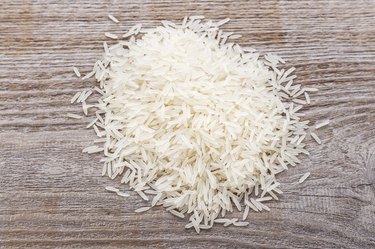
The glycemic index can help you determine how different foods affect your body's glucose levels. Carb-rich foods, which tend to be high on the glycemic index, often increase your body's blood glucose substantially. However, there are certain exceptions, like basmati rice.
Tip
According to an April 2015 report in the journal Critical Reviews in Food Science and Nutrition, basmati rice has a glycemic index value between 50 and 58. Instant, precooked and presoaked rice products tend to have elevated glycemic index values.
Video of the Day
What Is the Glycemic Index?
Different foods and beverages affect your body's blood glucose levels in different ways. Certain people, like those with diabetes, need to carefully monitor these changes.
Video of the Day
The glycemic index can help you monitor the way food products affect your body's glucose levels. According to Harvard Health Publishing, foods that have low glycemic index values release glucose slowly, while foods with high glycemic index values release glucose rapidly.
The Diabetes Center at the University of California, San Francisco, says that the glycemic index scale can be split into three main groups. Foods can have either low, medium or high glycemic index values. Low glycemic index values tend to be 55 or less, medium glycemic index values tend to range between 56 and 69, and high glycemic index foods have values of 70 or above.
In general, low glycemic index foods are considered healthier as they can help support weight loss. Low glycemic foods are also the primary types of foods that prediabetics and diabetics should consume.
There are many different low glycemic index foods. Harvard Health Publishing's glycemic index food chart states that legumes like soy beans, vegetables like carrots and fruits like apples and oranges are all low on the glycemic index.
However, high glycemic index foods also have their benefits. They can help prevent hypoglycemia and are particularly healthy choices for athletes, both before and after exercise. Harvard Health Publishing's glycemic index food chart states that high glycemic index foods include carbohydrate-rich products like rice, porridge and bread.
Read more: 16 Diet-Friendly Healthful Carbs
Glycemic Index of Basmati Rice
In general, rice is considered to be fairly high on the glycemic index. However, according to an April 2015 report in the journal Critical Reviews in Food Science and Nutrition, different types of rice can have different glycemic index values.
For example, Harvard Health Publishing's glycemic index food chart states that boiled white rice tends to have a high glycemic index value of 73. Brown rice has a medium glycemic index value of 68.
However, the report in the journal Critical Reviews in Food Science and Nutrition reported that the glycemic index of basmati rice ranges between 50 and 58. This means that basmati rice is a low or medium glycemic index food product.
The glycemic index of basmati rice makes it a very healthy carbohydrate choice. However, don't assume that all rice is comparable to basmati rice. Rice products can differ from one another substantially.
High Glycemic Index Rice Products
Certain rice products may need to be off limits for people who struggle to manage their blood sugar. For example, a January 2014 study in the International Journal of Food Science and Nutrition reported that jasmine rice's glycemic index tends to be 96 or above (the exact value depends on the brand). Similarly, the report in Critical Reviews in Food Science and Nutrition stated that Thai glutinous rice and Japanese Koshikari rice had similarly high values.
You should also be careful of the way you prepare your rice and the types of products you purchase. Basmati rice is very healthy and has a lower than average glycemic value. However, you should be aware that certain factors can increase its glycemic value.
Like other rice products, basmati rice is available in a variety of ways. You might find it packaged in an easy-cook pouch or incorporated into pre-prepared meals.
Try to avoid these types of products if you're trying to consume low glycemic index foods. The report in Critical Reviews in Food Science and Nutrition found that these products tend to have higher glycemic index values than regular rice that you'd cook from scratch.
The way you cook your rice can also affect its glycemic index value. Soaking your rice before cooking it and then cooking your rice in different water can raise its glycemic index value. Similarly, basmati rice that's boiled for long periods or overcooked may also have a higher than average glycemic index value.
- Harvard Health Publishing: "Glycemic Index for 60+ Foods"
- Critical Reviews in Food Science and Nutrition: "The Glycaemic Index of Rice and Rice Products: A Review, and Table of GI Values"
- Diabetes Center at the University of California, San Francisco: "Glycemic Index and Glycemic Load"
- International Journal of Food Science and Nutrition: "Glycemic Index of American-Grown Jasmine Rice Classified as High"